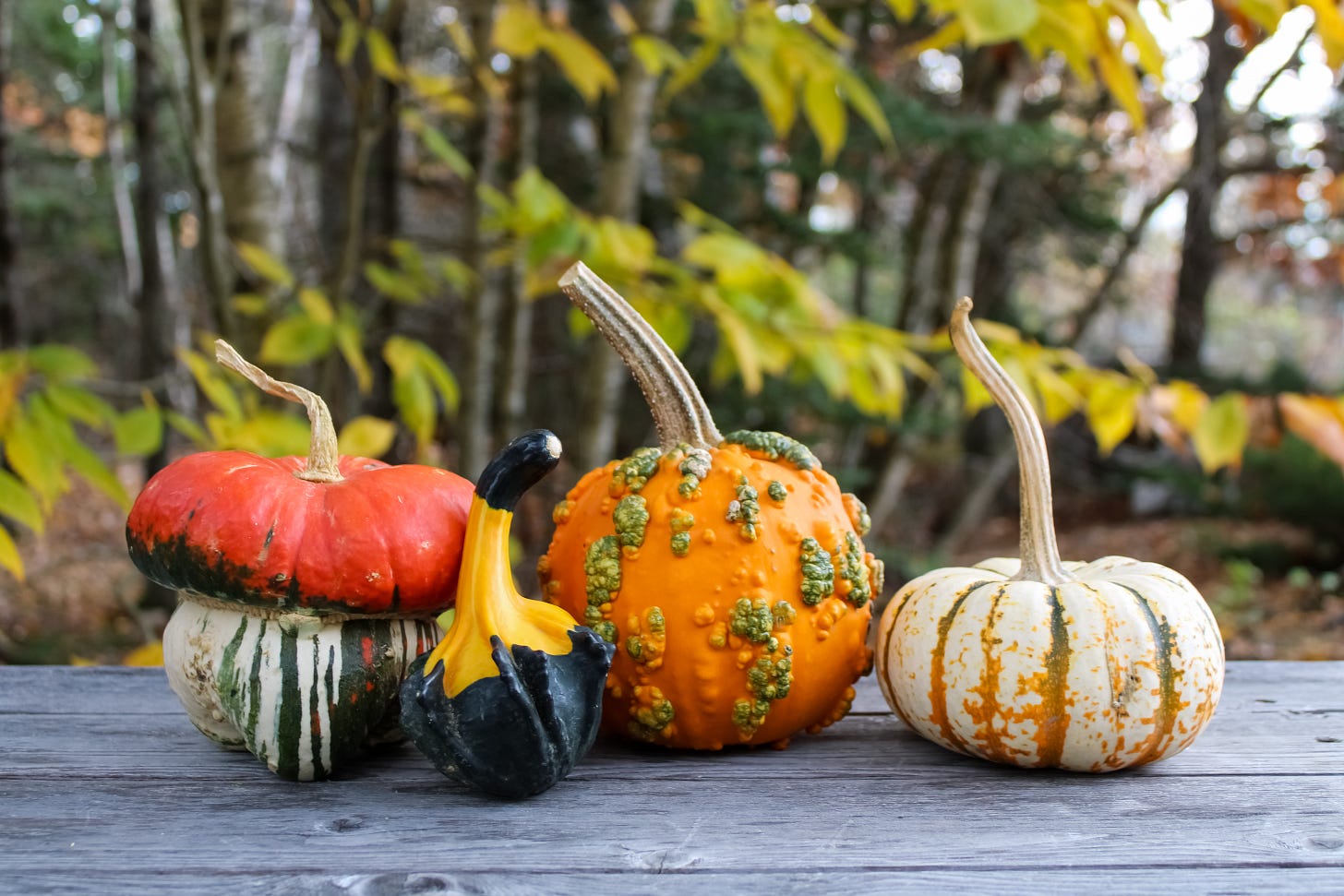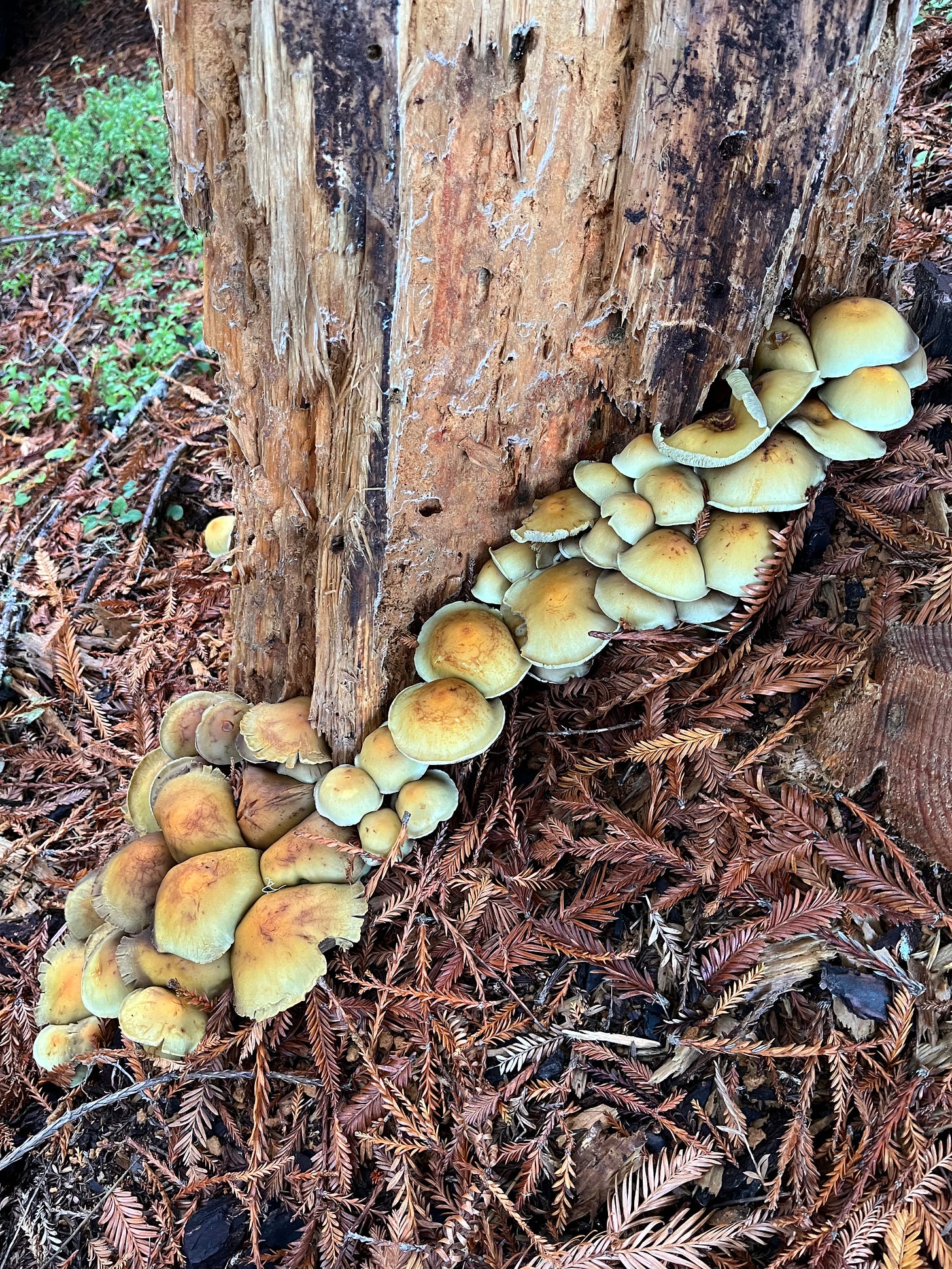The Art of Thanksgiving
A new film on gratitude, musings on acts of restoration and giving thanks.

You’re at Mother E, a free newsletter exploring our connections to nature and other species in a climate-changing world. If you missed the last edition, it’s here: Animals that vote— solving group conflicts.
If this newsletter gets shortened by an email program or the images don’t show, you can read it on the website here. To get Mother E coming to your email box every other Sunday, sign up below.
THE RETURN OF RAIN last week to the Mendocino coast and across the region was a welcome reprieve for a drought-parched landscape. I could almost hear a sigh of relief from the yellowing redwoods, and the Earth sent up its own celebratory balloons in the form of mushrooms.
Many of us take nature’s services for granted. Sunshine, rain, the growth of plants leading to autumn apples and colorful squashes are miracles that deserve our gratitude. Here in the U.S., we celebrate Thanksgiving this week, so I wanted to reflect on that theme.
Food is one blessing the land gives us. I’ll be baking an Eggnog Sweet-Potato pie this week, and dinner last night included green and yellow beans from local Oz Farm sautéed with garlic and lemon zest. I turned the zingy white turnips into a hearty stew and the four varieties of local apples into satisfying cinnamon baked-apple slices with maple syrup. The plant world dominates as ingredients for the foods in grocery aisles and our kitchens.
All this bounty comes from Mother Nature’s services, which continue as long as stable Earth conditions exist. I realize that not all people or countries have the advantages we have, and those food-growing benefits of nature are subject to changing conditions.
In the last two weeks, at the United Nations Convention of Parties (COP27) in Egypt, 35,000 delegates from 200 countries gathered to work on solutions to the growing climate crisis. Africa and the Global South, regions experiencing extreme climate shock, are asking for more help to feed and adjust to these challenging times to avoid a worse hunger crisis.
If we can raise corn, cabbage, and cucumbers, we can also raise consciousness to fix and restore our world.
Their plea reminds me of the theory of reciprocity, defined by Merriam-Webster as “the quality or state of being reciprocal : mutual dependence, action, or influence.”
The actions of some are influencing the lives of others, so fairness says reparations to people affected by extreme climate are appropriate and necessary. But beyond that, the food-growing breakdown in parts of the world is an early indicator of what could happen to the rest of us without sufficient action in the coming several years.
We are a human family globally, dependent upon the services of a stable Earth. If we can raise corn, cabbage, and cucumbers, we can also raise consciousness to fix and restore our world.
What does raising consciousness look like? It may start with paying closer attention to what we still have, appreciating it, and supporting it.
This month saw the release of a new documentary film, Gratitude Revealed, by Louie Schwartzberg (the award-winning producer of Fantastic Fungi). It’s a heart-warming reminder of our mutual dependence and human flair for connection, told in beautiful cinematography and memorable interviews. The movie trailer is below and is now available on several online platforms and in some theaters.
Thanksgiving can be a verb, and the art of practicing it brings us back to a realization of a mutual circle of care. As we take resources from the Earth (oxygen, plants, animals, minerals and metals, trees for building, and precious water, we enter an unspoken commitment to give back as best we can.
How are commitments back to our Earth expressed? There are thousands of ways, but mostly they evolve from observing a location and community. What’s missing or needed that you could provide? What group is doing something you admire, and how could you participate in making them more successful? Every act counts, whether helping people, animals, plants, parks, forests, beaches, or society. Plus, along the way, we also need to find ways to ditch fossil fuels and expand green energy.
If you are able to, add another act of restoration or care for the world’s big needs now.
My work is loving the world.
Mary Oliver, poet
My small act of thanksgiving this month is to plant half a dozen more pollinator bushes around our property. I’ve been observing the hummingbirds looking for food, the butterflies flitting by seeking more flowers, and the bees ganging up on a single lavender bush. Spring is a good time to plant, but fall can be good too, in mild climates.
I dug the hard soil for a couple of hours, added some amendments, and tucked the new deer-resistant plants in with a thorough watering. Planting is a lesson in waiting and a partnership with the elements—rain, soil, and sun. It’s also an act of faith that the life force on Earth will take over and raise those plants with a bit of help. In plants we trust— and with trust, we plant.
This wondrous and highly-evolved Earth will partner with us if we care back in return.
In this season of giving thanks, I wish you the bounty of Earth, natural mysteries to uncover, and the blessing of connections with those you love.
Robin Applegarth
Did you know?
What is the word for two trees growing together so their trunks become one? In logged, second-growth redwood forests, these conjoined trees are common. Author Rob Macfarlane tells us the word for this is “inosculation,” from Latin meaning “to kiss inwards.”


More music creates more mushrooms! Legendary mycologist Paul Stamets was on the Sing For Science podcast (Season 3, Episode 6) with musician Isaac Brock. They talked about how the underground mycelium is stimulated to grow by low-frequency sound waves such as thunder (rain is coming!) or music. You can listen to them at https://t.co/57Jlq4eaxq and Stamets comes on at about 7.50 minutes in.

Buildings and cities can be designed to be as generous and life-producing as the wild land or forest next door. I loved this meadow-based discussion between two thought leaders: Kate Raworth (Doughnut Economics) and Janine Benyus (Biomimicry). It’s 14.5 minutes.
I like to hear from readers!
You can comment at the button above, respond to this email to reach me privately, or reach out on Twitter @RobinApplegarth.
Thank you for reading Mother E and for your involvement in making the world a better place!
Not subscribed yet? Mother E is a free newsletter about our connections to other species in a climate-changing world. Sign up below to have it delivered to your email box every other Sunday.




I enjoyed the biomimicry discussion, thanks for sharing.
Thank you for the lovely sentiment you expressed below, I wish you the very same.
"In this season of giving thanks, I wish you the bounty of Earth, natural mysteries to uncover, and the blessing of connections with those you love."